.gif)
Seriation (archaeology)
Encyclopedia
In archaeology
, seriation is a relative dating
method in which assemblages or artifacts
from numerous sites, in the same culture, are placed in chronological order. Where absolute dating
methods, such as carbon dating, cannot be applied, archaeologists have to use relative dating
methods to date archaeological finds and features. Seriation is a standard method of dating in archaeology. It can be used to date stone tools, pottery fragments, and other artifacts. In Europe, it has been used frequently to reconstruct the chronological sequence of graves in a cemetery (e.g. Jørgensen 1992; Müssemeier, Nieveler et al. 2003).
in the late nineteenth century. He found that the graves he was uncovering contained no evidence of their dates and their discrete nature meant that a sequence could not be constructed through their stratigraphy.
Petrie listed the contents of each grave on a strip of cardboard and swapped the papers around until he arrived at a sequence he was satisfied with. He reasoned that the most accurate sequence would be the one where concentrations of certain design styles had the shortest duration across the sequence of papers (Renfrew and Bahn 1996, p.116; Kendall 1971, p.215; Shennan 1997, p.341)). Whereas Petrie is considered the inventor of contextual seriation, Bainerd (1951) and Robinson (1951) were the first to address the problem of frequency seriation (Shennan 1997, p.342)).
. In addition, it is vital that the lifespans of the different design styles overlap. Following these rules, an assemblage of objects can be placed into sequence so that sites with the most similar proportions of certain styles are always together (Lock 2003, p.125).
frequently is the basis of a seriation. Errors in typology result in errors in seriation: For example, if a certain design style had two peaks in popularity (bimodal distribution
), this design style is not appropriate for seriation and its inclusion in the analysis may result in strange results.
Some design styles were used for a very long time as the shape constructed was handy and no improvement or ornament was added. Of course, these design styles are not eligible for chronological seriation. For example, knives in early medieval times in Europe are said to show no chronological variation.
In addition to temporal organization, seriation results may reflect assemblage differences in social status, age, sex or those resulting from regional variation (or a combination of two or more of these factors). Shennan (1997, p.343) presents a seriation result of Danish hoard
s based on artefact types like daggers, axes, and swords. The result is not a chronological sequence due to the selection of types, the ordering seems to start with extremely male hoards and ends with extremely female ones.
(1971), Petrie's paper showed already a deep understanding of the mathematics of the seriation problem (Quote: "..in my view Petrie should be ranked with the greatest applied mathematicians of the nineteenth century"). In Baxter's (2003, p.8) list of landmarks of statistics in archaeology the paper of Robinson (1951) is the first entry. Robinson based his frequency seriation method on a similarity matrix
. In 1971, Kendall proposed the use of multidimensional scaling
techniques for seriation problems, and this approach has also been used by some other scientists (see Baxter 2003, pp.202–203). Baxter also presents a review of statistical methods for seriation and a description of these approaches (pp.202–207). In 1975, Doran and Hodson (pp.269–281) summarized the state of the art of seriation methods thoroughly, giving detailed descriptions of Kendall's and Robinson's approaches.
. The sequence of the first axis of a correspondence analysis is considered the best seriation order (Shennan 1997, p.342; Lock 2003, p.127; Jensen & Høilund Nielsen 1997). Using this technique, not only the sequence of the objects but also those of the design styles is established. Note that external evidence is needed to establish the direction of the sequence calculated, i.e. the method does not tell whether the first object in the sequence is the oldest or the youngest object.
Kendall (1971) applied multidimensional scaling
to the cemetery data of Münsingen. The resulting scatterplot
showed the form of a horse-shoe where the graves were arranged on the curve according to their chronological order. Similarly, a mapping of the component scores for the first two axes of the correspondence analysis
result will display a parabola
if the design styles considered are controlled by one factor only (like chronology). This is called the arch effect by Hill and Gauch (1980). Both Kendall and Jensen & Høilund Nielsen (1997) created artificial data sets to show that the parabola results in ideal circumstances. Therefore, it is recommended inspecting the scatterplot of the first two axes of correspondence analysis
to find out if other factors play a role as well (see Examples 2 and 3).
If more than one factor is important, the arch effect may distort the results. Hill and Gauch (1980) presented a method to remove this effect.
In 2003, Groenen and Poblome adapted the correspondence analysis algorithm to combine seriation with absolute dates and stratigraphic relationships.
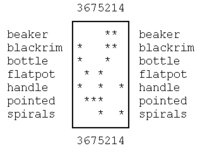
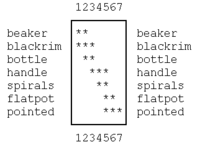
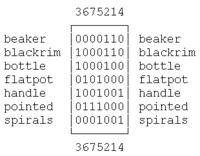 The raw data are stored in an unsorted binary contingency table
The raw data are stored in an unsorted binary contingency table
indicating which design style can be found in which context by a star symbol. For example, consider the first column: context 3 contains the design styles blackrim, bottle, and handle. A beaker is contained in contexts 1 and 2. Contextual seriation sorts the design styles and the contexts in such a way that the star symbols are found as close as possible to the diagonal of the table. Of course, for a small examples like this, no computer programs are needed to find the best ordering, but for larger data sets like the 900 graves studied by Petrie they are extremely helpful.
by WinBasp. Initially 60 contexts (called units in WinBasp) were created along with 50 types. The contexts were labeled in chronological order by numbers 01 to 60, the types are labeled in the form T00001 to T00050. If a type is represented by one object only this object is not relevant for the chronological sequence as it does not provide a link to another context. Similarly, contexts containing one object only are irrelevant for seriation. Therefore, the contexts with one or no object and types represented by one object or not at all were eliminated. The resulting raw simulated data consisting of 43 contexts and 34 types are shown on the left. As expected, the dots indicating the occurrence of a type in a context are close to the diagonal of the table.
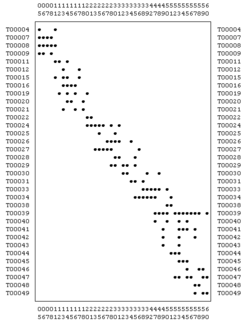
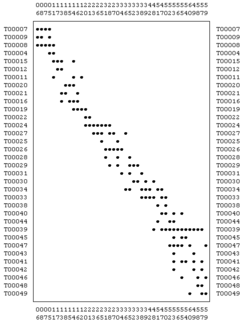
The image on the right hand side shows the result of the seriation for this data set. Note that the dots are even more compact along the diagonal of the table compared to the raw data. This shows a minor problem of seriation: In fact, the intervals of production may be somewhat longer than those calculated by the algorithm. In general, the sequences of contexts and types calculated by a seriation algorithm are not the correct chronological sequences but they are fairly close.

The image above shows the scatterplot with the typical parabola shape of the first two axes of a correspondence analysis
for the contexts of the simulated data set.
 The contingency table shows 29 contexts with ideal seriation data as created by Kendall and Jensen & Høilund Nielsen (see above). With each new context a new type appears and another type disappears. For this regular data, it seems reasonable to assume constant time intervals for contexts adjacent in time.
The contingency table shows 29 contexts with ideal seriation data as created by Kendall and Jensen & Høilund Nielsen (see above). With each new context a new type appears and another type disappears. For this regular data, it seems reasonable to assume constant time intervals for contexts adjacent in time.
The correspondence analysis results shown in the figures below were calculated on the basis of 49 contexts with ideal seriation data. The scatterplot of the first two correspondence analysis axes shows the typical parabola shape. The display of the scores on the first and the third axes exhibits points lying on a third degree polynomial curve. Similarly, the plot of the scores on the first and the fourth axes will show a fourth degree polynomial for ideal data – and so on.
Note that the distances of the scores for adjacent contexts on the first axis vary: At the beginning and the end, the distances are extremely small, the largest distances in the centre is about 30 times as large as the smallest distance. Hill and Gauch (1979) created a similar contingency table with a regular structure with each context containing six types. They note, too, that the within-context distances are smaller at the ends than in the middle. This was one of the reasons why they proposed an adjustment which is called detrended correspondence analysis
.
Nevertheless, some archaeologists think that a linear transformation
of the scores on the first axis on the basis of some known absolute dates will create good estimates for the unknown absolute dates, and this approach is the basis of the method presented by Groenen and Poblome (see above) to combine relative and absolute dates. This ideal example shows that a linear transformation might not be appropriate in all cases, though a simulation study by van de Velden, Groenen and Poblome comes to the conclusion that the predictions of the approach are quite good.
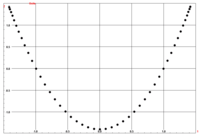

Archaeology
Archaeology, or archeology , is the study of human society, primarily through the recovery and analysis of the material culture and environmental data that they have left behind, which includes artifacts, architecture, biofacts and cultural landscapes...
, seriation is a relative dating
Relative dating
Relative dating is the science determining the relative order of past events, without necessarily determining their absolute age.In geology rock or superficial deposits, fossils and lithologies can be used to correlate one stratigraphic column with another...
method in which assemblages or artifacts
Artifact (archaeology)
An artifact or artefact is "something made or given shape by man, such as a tool or a work of art, esp an object of archaeological interest"...
from numerous sites, in the same culture, are placed in chronological order. Where absolute dating
Absolute dating
Absolute dating is the process of determining an approximate computed age in archaeology and geology. Some scientists prefer the terms chronometric or calendar dating, as use of the word "absolute" implies an unwarranted certainty and precision...
methods, such as carbon dating, cannot be applied, archaeologists have to use relative dating
Relative dating
Relative dating is the science determining the relative order of past events, without necessarily determining their absolute age.In geology rock or superficial deposits, fossils and lithologies can be used to correlate one stratigraphic column with another...
methods to date archaeological finds and features. Seriation is a standard method of dating in archaeology. It can be used to date stone tools, pottery fragments, and other artifacts. In Europe, it has been used frequently to reconstruct the chronological sequence of graves in a cemetery (e.g. Jørgensen 1992; Müssemeier, Nieveler et al. 2003).
Contextual and frequency seriation
Two different variants of seriation have been applied: contextual seriation and frequency seriation (Renfrew and Bahn 1996, pp.116–117). Whereas contextual seriation is based on the presence or absence of a design style, frequency seriation relies on measuring the proportional abundance or frequency of a design style. Contextual seriation is often used for reconstructing the chronological sequence of graves as only the presence or absence of a design style or type is important. Frequency seriation is applied in case of large quantities of objects belonging to the same style. An example are assemblages of pottery sherds each including roughly the same range of types though in different proportions.History
Flinders Petrie excavated at Diospolis Parva in EgyptEgypt
Egypt , officially the Arab Republic of Egypt, Arabic: , is a country mainly in North Africa, with the Sinai Peninsula forming a land bridge in Southwest Asia. Egypt is thus a transcontinental country, and a major power in Africa, the Mediterranean Basin, the Middle East and the Muslim world...
in the late nineteenth century. He found that the graves he was uncovering contained no evidence of their dates and their discrete nature meant that a sequence could not be constructed through their stratigraphy.
Petrie listed the contents of each grave on a strip of cardboard and swapped the papers around until he arrived at a sequence he was satisfied with. He reasoned that the most accurate sequence would be the one where concentrations of certain design styles had the shortest duration across the sequence of papers (Renfrew and Bahn 1996, p.116; Kendall 1971, p.215; Shennan 1997, p.341)). Whereas Petrie is considered the inventor of contextual seriation, Bainerd (1951) and Robinson (1951) were the first to address the problem of frequency seriation (Shennan 1997, p.342)).
Description of the model
Assuming that design styles follow a bell curve of popularity – starting slowly, growing to a peak and then dying away as another style becomes popular – provides the basis for frequency seriation. It also assumes that design popularity will be broadly similar from site to site within the same cultureArchaeological culture
An archaeological culture is a recurring assemblage of artifacts from a specific time and place, which are thought to constitute the material culture remains of a particular past human society. The connection between the artifacts is based on archaeologists' understanding and interpretation and...
. In addition, it is vital that the lifespans of the different design styles overlap. Following these rules, an assemblage of objects can be placed into sequence so that sites with the most similar proportions of certain styles are always together (Lock 2003, p.125).
Pitfalls
The task of identifying design styles i.e. to form groups of objects belonging to the same design style is by no means trivial. Creating a typologyTypology (archaeology)
In archaeology a typology is the result of the classification of things according to their characteristics. The products of the classification, i.e. the classes are also called types. Most archaeological typologies organize artifacts into types, but typologies of houses or roads belonging to a...
frequently is the basis of a seriation. Errors in typology result in errors in seriation: For example, if a certain design style had two peaks in popularity (bimodal distribution
Bimodal distribution
In statistics, a bimodal distribution is a continuous probability distribution with two different modes. These appear as distinct peaks in the probability density function, as shown in Figure 1....
), this design style is not appropriate for seriation and its inclusion in the analysis may result in strange results.
Some design styles were used for a very long time as the shape constructed was handy and no improvement or ornament was added. Of course, these design styles are not eligible for chronological seriation. For example, knives in early medieval times in Europe are said to show no chronological variation.
In addition to temporal organization, seriation results may reflect assemblage differences in social status, age, sex or those resulting from regional variation (or a combination of two or more of these factors). Shennan (1997, p.343) presents a seriation result of Danish hoard
Hoard
In archaeology, a hoard is a collection of valuable objects or artifacts, sometimes purposely buried in the ground. This would usually be with the intention of later recovery by the hoarder; hoarders sometimes died before retrieving the hoard, and these surviving hoards may be uncovered by...
s based on artefact types like daggers, axes, and swords. The result is not a chronological sequence due to the selection of types, the ordering seems to start with extremely male hoards and ends with extremely female ones.
Three conditions for chronological seriation
Doran and Hodson (1975, p. 269) list three conditions that must be satisfied to obtain a chronological seriation result:- Regional variation must be kept to a minimum, i.e. assemblages must best be drawn from one locality.
- The objects analyzed must all come from a single cultural tradition.
- The traits or attributes included in the seriation must depend on cultural aspects (rather than on function).
Development of seriation methods
Nowadays, seriation results are no longer produced manually as in Petrie's times but by appropriate algorithms. Though according to David George KendallDavid George Kendall
David George Kendall FRS was an English statistician, who spent much of his academic life in the University of Oxford and the University of Cambridge. He worked with M. S...
(1971), Petrie's paper showed already a deep understanding of the mathematics of the seriation problem (Quote: "..in my view Petrie should be ranked with the greatest applied mathematicians of the nineteenth century"). In Baxter's (2003, p.8) list of landmarks of statistics in archaeology the paper of Robinson (1951) is the first entry. Robinson based his frequency seriation method on a similarity matrix
Similarity matrix
A similarity matrix is a matrix of scores which express the similarity between two data points. Similarity matrices are strongly related to their counterparts, distance matrices and substitution matrices.-Use in sequence alignment:...
. In 1971, Kendall proposed the use of multidimensional scaling
Multidimensional scaling
Multidimensional scaling is a set of related statistical techniques often used in information visualization for exploring similarities or dissimilarities in data. MDS is a special case of ordination. An MDS algorithm starts with a matrix of item–item similarities, then assigns a location to each...
techniques for seriation problems, and this approach has also been used by some other scientists (see Baxter 2003, pp.202–203). Baxter also presents a review of statistical methods for seriation and a description of these approaches (pp.202–207). In 1975, Doran and Hodson (pp.269–281) summarized the state of the art of seriation methods thoroughly, giving detailed descriptions of Kendall's and Robinson's approaches.
Correspondence analysis for seriation purposes
Today, the most popular seriation method both for contextual and frequency problems is based on correspondence analysisCorrespondence analysis
Correspondence analysis is a multivariate statistical technique proposed by Hirschfeld and later developed by Jean-Paul Benzécri. It is conceptually similar to principal component analysis, but applies to categorical rather than continuous data...
. The sequence of the first axis of a correspondence analysis is considered the best seriation order (Shennan 1997, p.342; Lock 2003, p.127; Jensen & Høilund Nielsen 1997). Using this technique, not only the sequence of the objects but also those of the design styles is established. Note that external evidence is needed to establish the direction of the sequence calculated, i.e. the method does not tell whether the first object in the sequence is the oldest or the youngest object.
Kendall (1971) applied multidimensional scaling
Multidimensional scaling
Multidimensional scaling is a set of related statistical techniques often used in information visualization for exploring similarities or dissimilarities in data. MDS is a special case of ordination. An MDS algorithm starts with a matrix of item–item similarities, then assigns a location to each...
to the cemetery data of Münsingen. The resulting scatterplot
Scatterplot
A scatter plot or scattergraph is a type of mathematical diagram using Cartesian coordinates to display values for two variables for a set of data....
showed the form of a horse-shoe where the graves were arranged on the curve according to their chronological order. Similarly, a mapping of the component scores for the first two axes of the correspondence analysis
Correspondence analysis
Correspondence analysis is a multivariate statistical technique proposed by Hirschfeld and later developed by Jean-Paul Benzécri. It is conceptually similar to principal component analysis, but applies to categorical rather than continuous data...
result will display a parabola
Parabola
In mathematics, the parabola is a conic section, the intersection of a right circular conical surface and a plane parallel to a generating straight line of that surface...
if the design styles considered are controlled by one factor only (like chronology). This is called the arch effect by Hill and Gauch (1980). Both Kendall and Jensen & Høilund Nielsen (1997) created artificial data sets to show that the parabola results in ideal circumstances. Therefore, it is recommended inspecting the scatterplot of the first two axes of correspondence analysis
Correspondence analysis
Correspondence analysis is a multivariate statistical technique proposed by Hirschfeld and later developed by Jean-Paul Benzécri. It is conceptually similar to principal component analysis, but applies to categorical rather than continuous data...
to find out if other factors play a role as well (see Examples 2 and 3).
If more than one factor is important, the arch effect may distort the results. Hill and Gauch (1980) presented a method to remove this effect.
In 2003, Groenen and Poblome adapted the correspondence analysis algorithm to combine seriation with absolute dates and stratigraphic relationships.
Example 1: Small contextual seriation
The small example below was inspired by Flinders Petrie's serial ordering of Egyptian pottery as published by Renfrew and Bahn (1996, p. 117).


Contingency table
In statistics, a contingency table is a type of table in a matrix format that displays the frequency distribution of the variables...
indicating which design style can be found in which context by a star symbol. For example, consider the first column: context 3 contains the design styles blackrim, bottle, and handle. A beaker is contained in contexts 1 and 2. Contextual seriation sorts the design styles and the contexts in such a way that the star symbols are found as close as possible to the diagonal of the table. Of course, for a small examples like this, no computer programs are needed to find the best ordering, but for larger data sets like the 900 graves studied by Petrie they are extremely helpful.
Example 2: Simulated data, seriation and correspondence analysis
The data presented in this example was simulatedComputer simulation
A computer simulation, a computer model, or a computational model is a computer program, or network of computers, that attempts to simulate an abstract model of a particular system...
by WinBasp. Initially 60 contexts (called units in WinBasp) were created along with 50 types. The contexts were labeled in chronological order by numbers 01 to 60, the types are labeled in the form T00001 to T00050. If a type is represented by one object only this object is not relevant for the chronological sequence as it does not provide a link to another context. Similarly, contexts containing one object only are irrelevant for seriation. Therefore, the contexts with one or no object and types represented by one object or not at all were eliminated. The resulting raw simulated data consisting of 43 contexts and 34 types are shown on the left. As expected, the dots indicating the occurrence of a type in a context are close to the diagonal of the table.


The image on the right hand side shows the result of the seriation for this data set. Note that the dots are even more compact along the diagonal of the table compared to the raw data. This shows a minor problem of seriation: In fact, the intervals of production may be somewhat longer than those calculated by the algorithm. In general, the sequences of contexts and types calculated by a seriation algorithm are not the correct chronological sequences but they are fairly close.

The image above shows the scatterplot with the typical parabola shape of the first two axes of a correspondence analysis
Correspondence analysis
Correspondence analysis is a multivariate statistical technique proposed by Hirschfeld and later developed by Jean-Paul Benzécri. It is conceptually similar to principal component analysis, but applies to categorical rather than continuous data...
for the contexts of the simulated data set.
Example 3: Ideal data, seriation and correspondence analysis

The correspondence analysis results shown in the figures below were calculated on the basis of 49 contexts with ideal seriation data. The scatterplot of the first two correspondence analysis axes shows the typical parabola shape. The display of the scores on the first and the third axes exhibits points lying on a third degree polynomial curve. Similarly, the plot of the scores on the first and the fourth axes will show a fourth degree polynomial for ideal data – and so on.
Note that the distances of the scores for adjacent contexts on the first axis vary: At the beginning and the end, the distances are extremely small, the largest distances in the centre is about 30 times as large as the smallest distance. Hill and Gauch (1979) created a similar contingency table with a regular structure with each context containing six types. They note, too, that the within-context distances are smaller at the ends than in the middle. This was one of the reasons why they proposed an adjustment which is called detrended correspondence analysis
Detrended Correspondence Analysis
Detrended correspondence analysis is a multivariate statistical technique widely used by ecologists to find the main factors or gradients in large, species-rich but usually sparse data matrices that typify ecological community data. For example, Hill and Gauch analyse the data of a vegetation...
.
Nevertheless, some archaeologists think that a linear transformation
Linear transformation
In mathematics, a linear map, linear mapping, linear transformation, or linear operator is a function between two vector spaces that preserves the operations of vector addition and scalar multiplication. As a result, it always maps straight lines to straight lines or 0...
of the scores on the first axis on the basis of some known absolute dates will create good estimates for the unknown absolute dates, and this approach is the basis of the method presented by Groenen and Poblome (see above) to combine relative and absolute dates. This ideal example shows that a linear transformation might not be appropriate in all cases, though a simulation study by van de Velden, Groenen and Poblome comes to the conclusion that the predictions of the approach are quite good.


See also
- Ordination (statistics)Ordination (statistics)In multivariate analysis, ordination is a method complementary to data clustering, and used mainly in exploratory data analysis . Ordination orders objects that are characterized by values on multiple variables so that similar objects are near each other and dissimilar objects are farther from...
– same objective as seriation in archaeology, but mainly used in ecology - Archaeological contextArchaeological contextIn archaeology, not only the context of a discovery is a significant fact, but the formation of the context is as well. An archaeological context is an event in time which has been preserved in the archaeological record. The cutting of a pit or ditch in the past is a context, whilst the material...
- Archaeological associationArchaeological associationAssociation in archaeology has more than one meaning and is confusing to the layman. Archaeology has been critiqued as a soft science with a somewhat poor standardization of terms.-Finds and objects:...
- Harris matrixHarris matrixThe Harris matrix is a tool used to depict the temporal succession of archaeological contexts and thus the sequence of deposition on a 'dry land' archaeological site. The matrix reflects the relative position and stratigraphic contacts of observable stratigraphic units, or contexts. The Matrix was...

